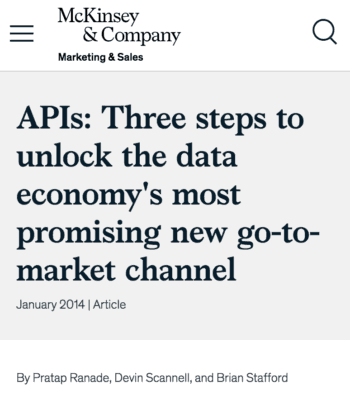If Integrations Drive SaaS Success, Where’s the Data?
By
When you’re in the business of building integrations for SaaS companies, it’s easy to recycle slogans about the “power of integrations” and how “integrations drive customer retention.”
When we make our pitch for more/better integration, most SaaS leaders nod along eagerly. But occasionally a contrarian challenges our convention wisdom.
And when they do, we listen like a quiet coyote.
We’ve been lucky to hear several shrewd nuanced counter-arguments, which boil down to:
- Disappointment stemming from a tech-enabled partnership that took forever to launch and then failed to produce any results
- Less is More for a simple SaaS built around a narrow solution. Wonky integrations can easily muddy up a sleek UX, not to mention add to the support burden.
- Fear of Technical Debt from the grizzled SaaS leader who has suffered through the pain of building scaleable integrations- and then maintaining them over time.
Despite these common concerns, it’s hard to argue that more/better/easier integration isn’t a general B2B software buying trend, for some good reason.
When one of our SaaS clients pushes back on our integration fight song, my reflex is to start googling for the “missing link” case study that will instantly change hearts & minds- and re-open wallets and purchase orders.
But sadly, I’m always disappointed. The data-driven industry “literature” (as it were) is quite thin on this most essential topic. How weird, given the manybytes of SaaS business metrics published every week by various gurus, venture capitalists, and analysts.
Case Studies to Date
Too few useful case studies exist in the wild, but they’re worth a read.
First prize goes to this analysis on the Zapier blog about the relationship between integration and churn for Typeform. It’s by far the most detailed mathematical analysis I’ve found. The only downside is that it’s now 3+ years old, but it’s still a very valid take on the topic.
My second recommendation is this very recent (Sept 2018) roundup from Zapier.
In addition to their Typeform post, author Adam DuVander points to five data-supported cases from Acuity Scheduling, Typeform, Evernote, Freshbooks, and Autopilot.
Acuity in particular provides a very persuasive case. They correlated “integrated users” vs “non-integrated users” to in-app activity, and again to freemium conversion. Acuity’s research surfaced the most likely customer among their trials: users who enabled an integration early on, earlier the better. This turns out to be a highly reliable and actionable “buy signal.” Acuity’s findings also helped hone integration-centric email messaging.
As useful as this case is, most of the others are a little stale and are not as well-supported as Acuity’s case. (2014 FreshBooks and Evernote data; the Autopilot stats are from 2015 and stay at a high level.)
Good start, but no where near enough to make the case beyond a shadow of a doubt.
Salesforce Mythology
In the past we’ve been fond of this 2015 Harvard Business Review article (“The Strategic Value of APIs“).
Half of Salesforce’s revenue from APIs? Case closed!
The only problem is that the venerable HBR didn’t do its homework, a detail I pursued years after first citing the factoid.
HBR merely reblogged another post (from TechTarget). The data underlying TechTarget’s claim? Null. Not even a Benioff humble brag.
UPDATE MAY 2, 2019: We think we found the source of this oft-repeated metric: McKinsey.
None of the downstream repeaters of the 50% figure linked to McKinsey. However, the timing of the article and the reputation of the authoring brand convinces me that this is almost certainly source used by TechTarget and Harvard Business Journal.
It’s hard to argue with the brilliant and respected minds at McKinsey. But I can’t help but point out that they provide no citation to data or a primary source for this powerful factoid, either. (Perhaps SalesForce is a McKinsey client?)
Some more good news: I recently spoke in person with a SalesForce employee “with knowledge of the situation” who confirmed that SalesForce attributes “at least 50%” to its API. “I’d be surprised if it wasn’t higher” was their comment.
While not the study we’d all like to read, it certainly gives us comfort to use the “50% number” as appropriate.
Irresistible Confirmation Bias
But even with this “confirmation,” we’d still all be better off with more specific data, because it’s so wicked easy to want this Salesforce number to be true.
Fifty percent of Salesforce’s 2018 revenue would be $6.5 Billion! (Interestingly, almost exactly what Salesforce spent to acquire Mulesoft, one of the fastest growing integration platforms in our space.)
6,500,000,000 proof points would be so cool to have. But since I can’t find actual evidence in numbers, I’m not willing to rest my case on the Salesforce example, even with the confirmation I received.
This thought process repeats itself again and again. Along the way, I’ve found plenty of testimonial anecdotes prepared by companies that really, really, really want their “integration drives SaaS success” mantra to be chanted across SaaSlandia.
It’s a bummer that so many of their “white papers” and testimonials provide more truthiness than trustable data.
Where’s the Beef?
Given the huge explosion of SaaS revenue, you have to wonder why so few data-supported case studies on the whole API integration thing?
Is it because:
- The importance of integration is just so obvious, nobody needs to prove it? (Meh), or
- Most SaaS leaders see “integration” as “offer an API and check the box, class dismissed” (maybe) or
- Its hard work to pull API data, analyze it honestly, and write up the results (Word.)
SaaSlandia needs somebody to tackle this gap in the literature, and build a fact-based case. I nominate Left Hook of course, but we’d love to partner. There’s so much work to go around, let’s share!
We Need “Drop the Mic” Evidence
And to get there, we need some well-integrated mature companies to provide more data with more analysis. We also need young startups to track causal or correlated ROI over time, ideally from Day 1.
If your company is a candidate, Left Hook would love to partner on analysis and distribution of your findings.
Together let’s prove, disprove, or inject nuance into this “integration is good” theory, even if the resulting story might complicate or diminish our marketing messages.
After almost five years of integration-building, Left Hook’s team comes to this both curious and sober. We know not all integrations are layups and home runs; not all integrations make sense for all software companies; and some are just bad distractions.
Part of our job is to parse the difference and apply a nuanced, balanced view to our clients’ business strategy.
If we know anything, we know we need to dig into this further. Can you help?
This is the first in a series of posts on the topic. Have some data to share, or a perspective? Chat with us.


